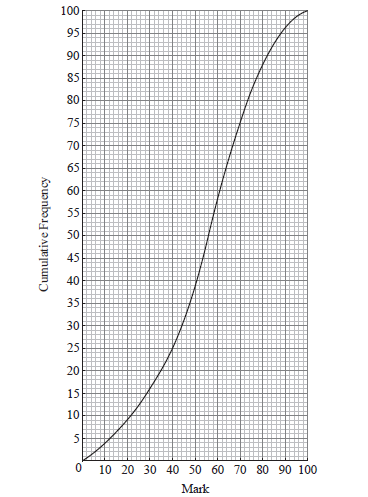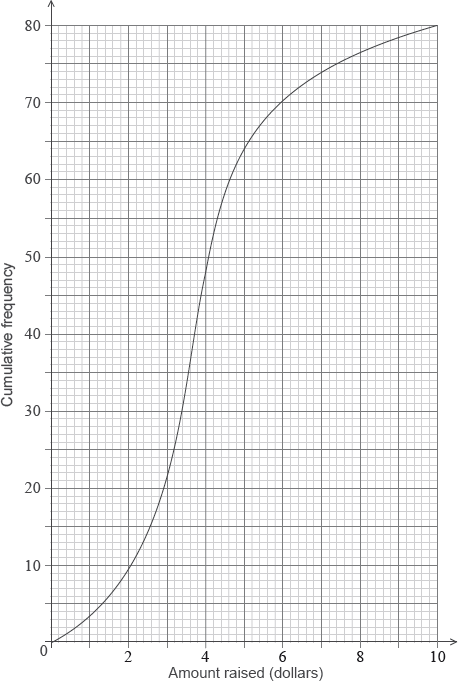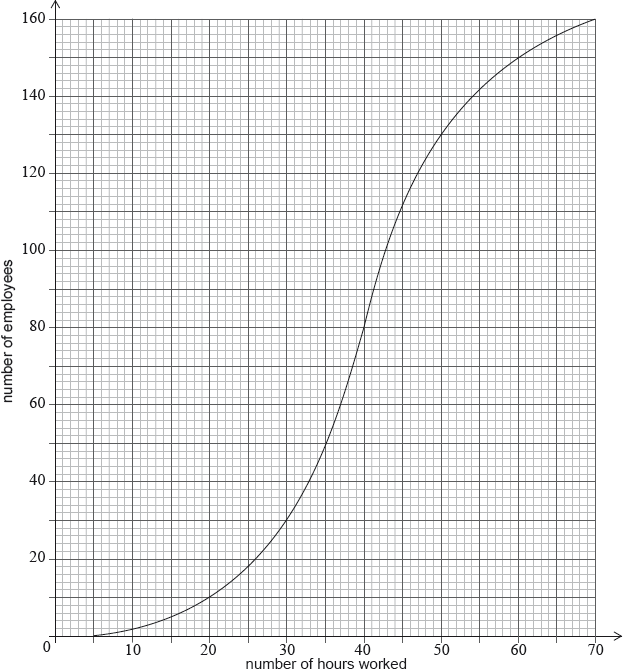Question
A box contains 100 cards. Each card has a number between one and six written on it. The following table shows the frequencies for each number.

Calculate the value of k.
Find
(i) the median;
(ii) the interquartile range.
Answer/Explanation
Markscheme
evidence of using \(\sum {{f_i} = 100} \) (M1)
\(k = 4\) A1 N2
[2 marks]
(i) evidence of median position (M1)
e.g. 50th item, \(26 + 10 + 20 = 56\)
\({\text{median}} = 3\) A1 N2
(ii) \({Q_1} = 1\) and \({Q_3} = 5\) (A1)(A1)
\({\text{interquartile range}} = 4\) (accept 1 to 5 or \(5 – 1\) , etc.) A1 N3
[5 marks]
Question
The cumulative frequency curve below represents the marks obtained by 100 students.

Find the median mark.
Find the interquartile range.
Answer/Explanation
Markscheme
evidence of median position (M1)
e.g. 50, line on sketch
median is 56 A1 N2
[2 marks]
lower quartile \(= 40\) , upper quartile \(= 70\) (A1)(A1)
interquartile range \(= 30\) A1 N3
[3 marks]
Question
The weekly wages (in dollars) of 80 employees are displayed in the cumulative frequency curve below.
(i) Write down the median weekly wage.
(ii) Find the interquartile range of the weekly wages.
The box-and-whisker plot below displays the weekly wages of the employees.
Write down the value of
(i) \(a\) ;
(ii) \(b\) ;
(iii) \(c\) .
Employees are paid \($\ 20\) per hour.
Find the median number of hours worked per week.
Employees are paid \(\$ 20\) per hour.
Find the number of employees who work more than \(25\) hours per week.
Answer/Explanation
Markscheme
(i) median weekly wage \(= 400\) (dollars) A1 N1
(ii) lower quartile \(= 330\), upper quartile \(= 470\) (A1)(A1)
\({\text{IQR}} = 140\) (dollars) (accept any notation suggesting interval \(330\) to \(470\)) A1 N3
Note: Exception to the FT rule. Award A1(FT) for an incorrect IQR only if both quartiles are explicitly noted.
[4 marks]
(i) \(330\) (dollars) A1 N1
(ii) \(400\) (dollars) A1 N1
(iii) \(700\) (dollars) A1 N1
[3 marks]
valid approach (M1)
e.g. \({\rm{hours = }}\frac{{{\rm{wages}}}}{{{\rm{rate}}}}\)
correct substitution (A1)
e.g. \(\frac{{400}}{{20}}\)
median hours per week \(= 20\) A1 N2
[3 marks]
attempt to find wages for 25 hours per week (M1)
e.g. \({\text{wages}} = {\text{hours}} \times {\text{rate}}\)
correct substitution (A1)
e.g. \(25 \times 20\)
finding wages \(= 500\) (A1)
65 people (earn 500\( \leqslant \)) (A1)
15 people (work more than 25 hours) A1 N3
[5 marks]
Question
A school collects cans for recycling to raise money. Sam’s class has 20 students.
The number of cans collected by each student in Sam’s class is shown in the following stem and leaf diagram.

The following box-and-whisker plot also displays the number of cans collected by students in Sam’s class.

There are 80 students in the school.

The mean number of cans collected is 39.4. The standard deviation is 18.5.
Each student then collects 2 more cans.
Find the median number of cans collected.
(i) Write down the value of \(a\).
(ii) The interquartile range is 14. Find the value of \(b\).
Sam’s class collected 745 cans. They want an average of 40 cans per student.
How many more cans need to be collected to achieve this target?
The students raise $0.10 for each recycled can.
(i) Find the largest amount raised by a student in Sam’s class.
(ii) The following cumulative frequency curve shows the amounts in dollars raised by all the students in the school. Find the percentage of students in the school who raised more money than anyone in Sam’s class.
(i) Write down the new mean.
(ii) Write down the new standard deviation.
Answer/Explanation
Markscheme
valid approach (M1)
eg\(\,\,\,\,\,\)between 10th and 11th, \(\frac{{8 + 8}}{2}\)
median \( = 38\) A1 N2
[2 marks]
(i) \(a = 20\) A1 N1
(ii) valid approach (M1)
eg\(\,\,\,\,\,\)\({Q_3} – {Q_1},{\text{ }}{Q_1} + 14,{\text{ }}b – 30 = 14\)
\(b = 44\) A1 N2
[3 marks]
valid approach (M1)
egx\(\,\,\,\,\,\)\(40 \times 20,{\text{ }}\frac{{x + 745}}{{20}},{\text{ }}40 – \frac{{745}}{{20}}\)
correct working (A1)
eg\(\,\,\,\,\,\)\(800 – 745,{\text{ }}20 \times 2.75\)
55 (more cans) A1 N2
[3 marks]
(i) most cans in Sam’s class \( = 50\) (A1)
5 ($) A1 N2
(ii) correct value of 64 or 16 A1
valid approach (M1)
eg\(\,\,\,\,\,\)\(\frac{{64}}{{80}},{\text{ }}80\% ,{\text{ }}80 – 64,{\text{ }}\frac{{16}}{{80}}\)
20% A1 N2
[5 marks]
(i) 41.4 (exact) A1 N1
(ii) 18.5 A1 N1
[2 marks]
Question
There are 10 items in a data set. The sum of the items is 60.
The variance of this data set is 3. Each value in the set is multiplied by 4.
Find the mean.
(i) Write down the value of the new mean.
(ii) Find the value of the new variance.
Answer/Explanation
Markscheme
correct approach (A1)
eg\(\,\,\,\,\,\)\(\frac{{60}}{{10}}\)
\({\text{mean}} = 6\) A1 N2
(i) new mean \( = 24\) A1 N1
(ii) valid approach (M1)
eg\(\,\,\,\,\,\)\({\text{variance}} \times {(4)^2},{\text{ }}3 \times 16\), new standard deviation \( = 4\sqrt 3 \)
new variance \( = 48\) A1 N2
[3 marks]
Question
A city hired 160 employees to work at a festival. The following cumulative frequency curve shows the number of hours employees worked during the festival.

The city paid each of the employees £8 per hour for the first 40 hours worked, and £10 per hour for each hour they worked after the first 40 hours.
Find the median number of hours worked by the employees.
Write down the number of employees who worked 50 hours or less.
Find the amount of money an employee earned for working 40 hours;
Find the amount of money an employee earned for working 43 hours.
Find the number of employees who earned £200 or less.
Only 10 employees earned more than £\(k\). Find the value of \(k\).
Answer/Explanation
Markscheme
evidence of median position (M1)
eg\(\,\,\,\,\,\)80th employee
40 hours A1 N2
[2 marks]
130 employees A1 N1
[1 mark]
£320 A1 N1
[1 mark]
splitting into 40 and 3 (M1)
eg\(\,\,\,\,\,\)3 hours more, \(3 \times 10\)
correct working (A1)
eg\(\,\,\,\,\,\)\(320 + 3 \times 10\)
£350 A1 N3
[3 marks]
valid approach (M1)
eg\(\,\,\,\,\,\)200 is less than 320 so 8 pounds/hour, \(200 \div 8,{\text{ }}25,{\text{ }}\frac{{200}}{{320}} = \frac{x}{{40}}\),
18 employees A2 N3
[3 marks]
valid approach (M1)
eg\(\,\,\,\,\,\)\(160 – 10\)
60 hours worked (A1)
correct working (A1)
eg\(\,\,\,\,\,\)\(40(8) + 20(10),{\text{ }}320 + 200\)
\(k = 520\) A1 N3
[4 marks]
Question
The following box-and-whisker plot shows the number of text messages sent by students in a school on a particular day.
Find the value of the interquartile range.
One student sent k text messages, where k > 11 . Given that k is an outlier, find the least value of k.
Answer/Explanation
Markscheme
recognizing Q1 or Q3 (seen anywhere) (M1)
eg 4,11 , indicated on diagram
IQR = 7 A1 N2
[2 marks]
recognizing the need to find 1.5 IQR (M1)
eg 1.5 × IQR, 1.5 × 7
valid approach to find k (M1)
eg 10.5 + 11, 1.5 × IQR + Q3
21.5 (A1)
k = 22 A1 N3
Note: If no working shown, award N2 for an answer of 21.5.
[4 marks]
Question
A data set has n items. The sum of the items is 800 and the mean is 20.
The standard deviation of this data set is 3. Each value in the set is multiplied by 10.
Find n.
Write down the value of the new mean.
Find the value of the new variance.
Answer/Explanation
Markscheme
correct approach (A1)
eg \(\frac{{800}}{n} = 20\)
40 A1 N2
[2 marks]
200 A1 N1
[1 mark]
METHOD 1
recognizing variance = σ 2 (M1)
eg 32 = 9
correct working to find new variance (A1)
eg σ 2 × 102, 9 × 100
900 A1 N3
METHOD 2
new standard deviation is 30 (A1)
recognizing variance = σ 2 (M1)
eg 32 = 9, 302
900 A1 N3
[3 marks]
